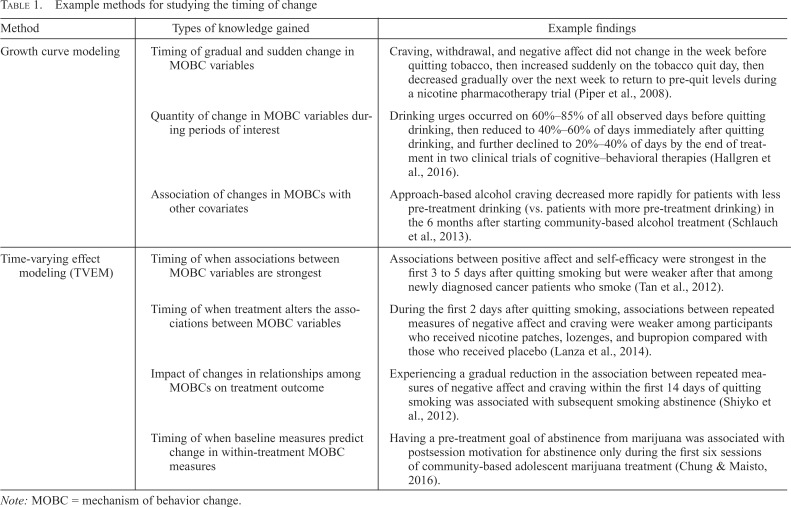Table 1.
Example methods for studying the timing of change
| Method | Types of knowledge gained | Example findings |
| Growth curve modeling | Timing of gradual and sudden change in MOBC variables | Craving, withdrawal, and negative affect did not change in the week before quitting tobacco, then increased suddenly on the tobacco quit day, then decreased gradually over the next week to return to pre-quit levels during a nicotine pharmacotherapy trial (Piper et al., 2008). |
| Quantity of change in MOBC variables during periods of interest | Drinking urges occurred on 60%–85% of all observed days before quitting drinking, then reduced to 40%–60% of days immediately after quitting drinking, and further declined to 20%–40% of days by the end of treatment in two clinical trials of cognitive–behavioral therapies (Hallgren et al., 2016). | |
| Association of changes in MOBCs with other covariates | Approach-based alcohol craving decreased more rapidly for patients with less pre-treatment drinking (vs. patients with more pre-treatment drinking) in the 6 months after starting community-based alcohol treatment (Schlauch et al., 2013). | |
| Time-varying effect modeling (TVEM) | Timing of when associations between MOBC variables are strongest | Associations between positive affect and self-efficacy were strongest in the first 3 to 5 days after quitting smoking but were weaker after that among newly diagnosed cancer patients who smoke (Tan et al., 2012). |
| Timing of when treatment alters the associations between MOBC variables | During the first 2 days after quitting smoking, associations between repeated measures of negative affect and craving were weaker among participants who received nicotine patches, lozenges, and bupropion compared with those who received placebo (Lanza et al., 2014). | |
| Impact of changes in relationships among MOBCs on treatment outcome | Experiencing a gradual reduction in the association between repeated measures of negative affect and craving within the first 14 days of quitting smoking was associated with subsequent smoking abstinence (Shiyko et al., 2012). | |
| Timing of when baseline measures predict change in within-treatment MOBC measures | Having a pre-treatment goal of abstinence from marijuana was associated with postsession motivation for abstinence only during the first six sessions of community-based adolescent marijuana treatment (Chung & Maisto, 2016). |
Note: MOBC = mechanism of behavior change.

